Archived Fire Damage Blog Posts
Space Heater Safety Tips
2/12/2024 (Permalink)
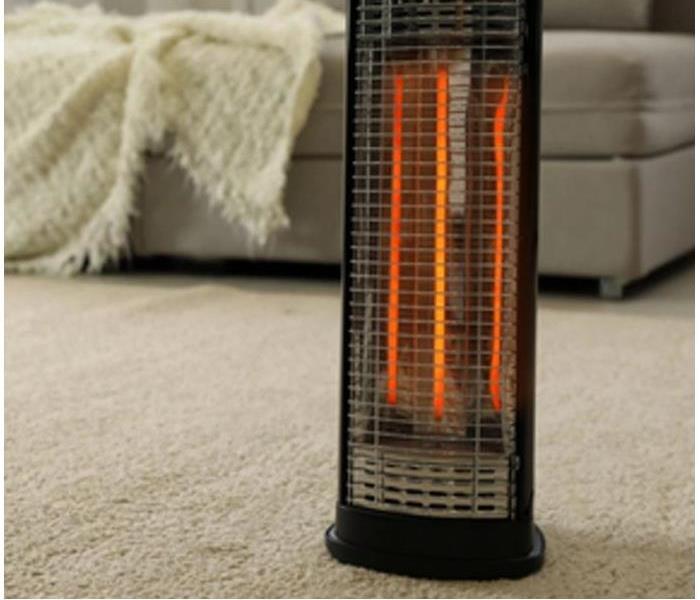 Space Heater in a Room
Space Heater in a Room
Heating equipment is the second leading cause of home fires in the United States. More than 65,000 home fires are attributed to heating equipment each year. These fire result in hundreds of deaths, thousands of injuries and millions of dollars in property damage.
Portable electric space heaters can be a convenient source of supplemental heat for your home in cold weather. Unfortunately, they can pose significant fire and electric shock hazards if not used properly. Fire and electrical hazards can be caused by space heaters without adequate safety features, space heaters placed near combustibles, or space heaters that are improperly plugged in.
Safety should always be a top consideration when using space heaters. Here are some tips for keeping your home safe and warm when it’s cold outside:
- Make sure your space heater has the label showing that it is listed by a recognized testing laboratory.
- Before using any space heater, read the manufacturer’s instructions and warning labels carefully.
- Inspect heaters for cracked or broken plugs or loose connections before each use. If frayed, worn or damaged, do not use the heater.
- Never leave a space heater unattended. Turn it off when you’re leaving a room or going to sleep, and don’t let pets or children play too close to a space heater.
- Space heaters are only meant to provide supplemental heat and should never be used to warm bedding, cook food, dry clothing or thaw pipes.
- Install smoke alarms on every floor of your home and outside all sleeping areas and test them once a month.
- Proper placement of space heaters is critical. Heaters must be kept at least three feet away from anything that can burn, including papers, clothing and rugs.
- Locate space heaters out of high traffic areas and doorways where they may pose a tripping hazard.
- Plug space heaters directly into a wall outlet. Do not use an extension cord or power strip, which could overheat and result in a fire. Do not plug any other electrical devices into the same outlet as the heater.
- Place space heaters on level, flat surfaces. Never place heaters on cabinets, tables, furniture, or carpet, which can overheat and start a fire.
- Always unplug and safely store the heater when it is not in use.
Fire Facts: Christmas Trees
11/27/2023 (Permalink)
Safety Tips
Use of lights that produce low heat, such as miniature lights, will reduce drying of the tree.
Always inspect light sets prior to placing them on the tree. If worn, replace with a new set.
Do not overload electrical circuits.
Always turn off the lights when leaving the house or when going to bed.
Monitor the tree for freshness. After Christmas or if the tree is dry, remove it from the house.
Find a recycling program near you.
Never burn any part of a Christmas Tree in a wood stove or fireplace.
Christmas Tree Safety Tips
12/5/2022 (Permalink)
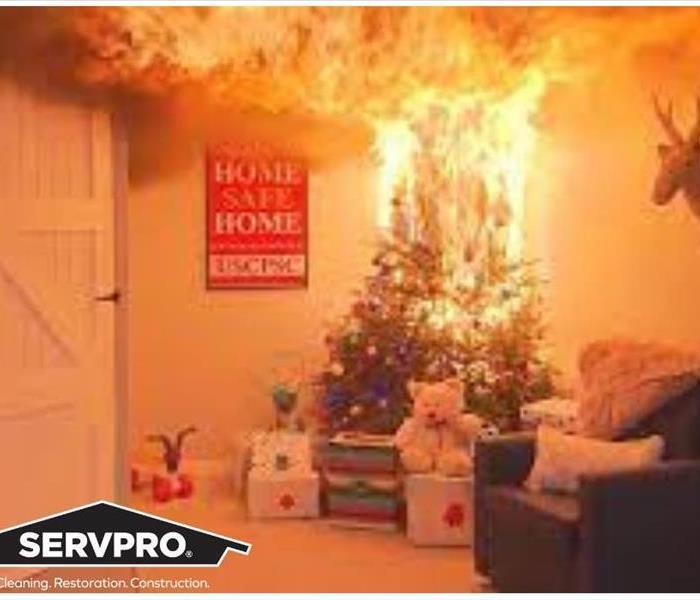 Christmas Tree Myth: A Christmas Trees is a fire hazard.
Christmas Tree Myth: A Christmas Trees is a fire hazard.
Safety Tips
Use of lights that produce low heat, such as miniature lights, will reduce drying of the tree.
Always inspect light sets prior to placing them on the tree. If worn, replace with a new set.
Do not overload electrical circuits.
Always turn off the lights when leaving the house or when going to bed.
Monitor the tree for freshness. After Christmas or if the tree is dry, remove it from the house.
Find a recycling program near you.
Never burn any part of a Christmas Tree in a wood stove or fireplace.
Provided by the National Christmas Tree Association: It's that time of year again. We'll all probably see the local TV news team do a Christmas Tree fire story. It'll show a dramatic image of a tree burning and the reporter will say with consternation, "If you get a Real Christmas Tree, this could happen to you….blah blah blah.”
Watching those stories every year, I can only wonder at the ethical standards of the TV station. This is clearly an example of sensational and misleading journalism. While I applaud efforts to teach people how to properly care for their farm-grown Christmas Tree and warn people about potential fire hazards, journalists have a responsibility to get the facts right.
A natural tree, especially a tree that is kept watered, is extremely difficult to ignite from an accidental ignition source found in a home. In fact, newspapers, magazines, boxes, bags and drapes are far more likely to be involved in a fire, but mentioning these before natural trees would still “miss the mark.” Media focus should be on the source of the fire in the first place. Educating the public about unattended or poorly placed candles, overloaded circuits and faulty wiring should be your priority. A cut Christmas Tree has NEVER, ever, ever in history CAUSED a fire. Fires are caused by sparks, flames, heat or chemical reactions. A plant (which is what a Christmas Tree is) can NOT cause a fire.
According to published reports of the National Fire Protection Association, a confirmed average of 111 fires per year in the U.S. were ones in which a cut tree was the first item ignited in a residential fire. During the same period of the report, an average of 28 million cut Christmas Trees were displayed. Divide 111 by 28 million. You get 0.0000039. Or 0.0004% rounded up. But watching local news reports on the topic, one would think it happened all the time.
Another item in the NFPA report you might find interesting is that fire officials state clearly that artificial trees also catch on fire every year. There is no testing lab or standards for those products to meet in order to print the words "flame retardant" on their packaging. They're really just words on a box. Fake trees catch on fire every year. Not very many, just like farm-grown trees. However, according to the NFPA report, 28% confirmed residential fires where a Christmas tree was the first item ignited involved a fake tree.
I hope these journalists realize just how erroneous and misleading and dramatized their stories like this are, and how scaring people with dramatic images of trees burning doesn't help to constructively provide tree care tips. It only hurts local farmers who grow the trees. Media stories that exaggerate the danger of a consumer item – or worse yet media stories that intentionally fake an event such as pouring gasoline over a Real Christmas Tree to demonstrate its flammability – can influence consumer behavior in a way that is unfair and unfortunate. It is journalistic sensationalism and does a disservice to the public and the product. Don't think they fake it? Just a few years ago, on The Tonight Show, Jay Leno showed a clip of a fireman pouring four gallons of gas on a tree just prior to doing one of those "this could happen to you" Christmas Tree fire stories for local TV news.
My hope is that consumers are not fooled by media who show these news reports. You can get the facts, including proper tree care practices, at www.realchristmastrees.org Have a safe and Merry Christmas!
Space Heater Safety Tips
12/2/2022 (Permalink)
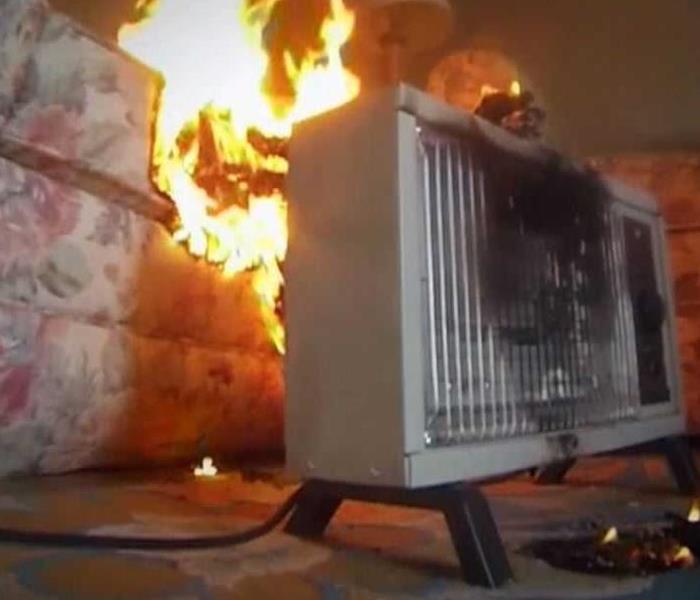 On average, fires caused by portable heaters cause 65 deaths and 150 injuries a year.
On average, fires caused by portable heaters cause 65 deaths and 150 injuries a year.
Heating equipment is the second leading cause of home fires in the United States. More than 65,000 home fires are attributed to heating equipment each year. These fire result in hundreds of deaths, thousands of injuries and millions of dollars in property damage.
Portable electric space heaters can be a convenient source of supplemental heat for your home in cold weather. Unfortunately, they can pose significant fire and electric shock hazards if not used properly. Fire and electrical hazards can be caused by space heaters without adequate safety features, space heaters placed near combustibles, or space heaters that are improperly plugged in.
Safety should always be a top consideration when using space heaters. Here are some tips for keeping your home safe and warm when it’s cold outside:
- Make sure your space heater has the label showing that it is listed by a recognized testing laboratory.
- Before using any space heater, read the manufacturer’s instructions and warning labels carefully.
- Inspect heaters for cracked or broken plugs or loose connections before each use. If frayed, worn or damaged, do not use the heater.
- Never leave a space heater unattended. Turn it off when you’re leaving a room or going to sleep, and don’t let pets or children play too close to a space heater.
- Space heaters are only meant to provide supplemental heat and should never be used to warm bedding, cook food, dry clothing or thaw pipes.
- Install smoke alarms on every floor of your home and outside all sleeping areas and test them once a month.
- Proper placement of space heaters is critical. Heaters must be kept at least three feet away from anything that can burn, including papers, clothing and rugs.
- Locate space heaters out of high traffic areas and doorways where they may pose a tripping hazard.
- Plug space heaters directly into a wall outlet. Do not use an extension cord or power strip, which could overheat and result in a fire. Do not plug any other electrical devices into the same outlet as the heater.
- Place space heaters on level, flat surfaces. Never place heaters on cabinets, tables, furniture, or carpet, which can overheat and start a fire.
- Always unplug and safely store the heater when it is not in use.
Tips for cooking with a fryer without causing a dangerous fire this Thanksgiving
11/14/2022 (Permalink)
Thanksgiving is a time for family and holiday traditions including taste tested, Thanksgiving recipes. It's also a time where family members may want to join in the food preparation so fire safety is important. With the speed of deep-frying a turkey, the irresistible flavor, and juiciness that results, turkey frying has become a Thanksgiving tradition for some. But turkey fryers have the potential to cause fire and serious injury, which is why organizations like Underwriters Laboratories and the National Fire Protection Association advises against using them. If you plan to deep-fry your holiday bird, be sure you know how to safely use the fryer, and take these precautions to protect yourself, your guests and your home.
Tips to help prevent deep fried turkey accidents
- Keep outdoor fryers off decks, out of garages and a safe distance away from trees and other structures.
- Make sure the turkey is thawed and dry before cooking. Ice or water that mixes into the hot oil can cause flare-ups.
- Watch the weather. Never operate a fryer outdoors in the rain or snow.
- Place the fryer on a level surface, and avoid moving it once it's in use.
- Leave 2 feet between the tank and the burner when using a propane-powered fryer.
- Follow the manufacturer's instructions to avoid overfilling. Oil can ignite when it makes contact with the burner.
- Choose a smaller turkey for frying. A bird that's 8 to 10 pounds is best; pass on turkeys over 12 pounds.
- Never leave fryers unattended.
- Purchase a fryer with temperature controls, and watch the oil temperature carefully. Cooking oil that is heated beyond its smoke point can catch fire. If you notice the oil is smoking, turn the fryer off.
- Turn off the burner before lowering the turkey into the oil. Once the turkey is submerged, turn the burner on.
- Wear goggles to shield your eyes, use oven mitts to protect your hands and arms and keep an "ABC" or grease-rated fire extinguisher close by. Do not use water or a garden hose on a fire related to turkey fryers.
- Skip the stuffing when frying turkey, and avoid water-based marinades.
- Keep children and pets away from the fryer at all times.
- Once finished, carefully remove the pot from the burner, place it on a level surface and cover to let the oil cool overnight before disposing.
- Opt for an oil-less fryer. This uses infrared heat, rather than oil, to cook the turkey.
After your turkey is prepared, remember these Thanksgiving food safety tips to help ensure your family has a safe, enjoyable holiday
Fire Damage Restoration Process
11/1/2022 (Permalink)
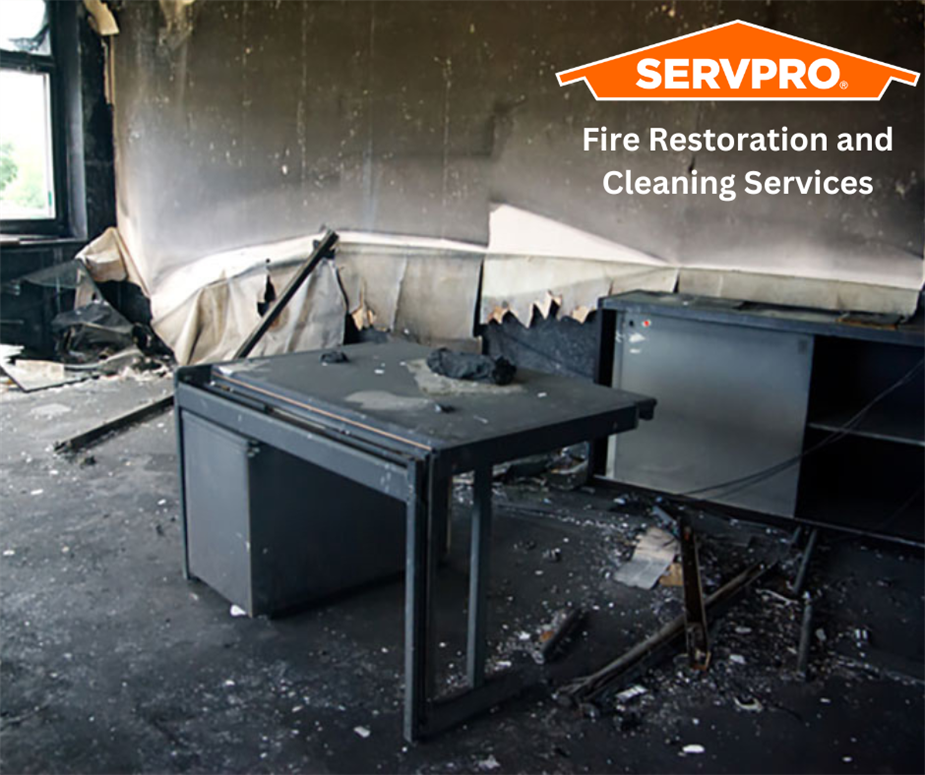 Fire Restoration and Cleaning Services
Fire Restoration and Cleaning Services
Call SERVPRO 24/7 in Mayes and Wagoner Counties for Fire Damage Cleanup and Restoration Services
After the fire trucks leave, your home likely suffers from fire and smoke damage and extensive water damage from firefighting efforts. SERVPRO® has the specialized fire restoration training needed to restore your home to pre-fire condition.
Every fire damage event is a little different, and requires a unique solution, but the general process stays the same. The steps listed below illustrate our process for the “typical” fire damage emergency.
Step 1: Emergency Contact
The restoration process begins when you give us a call. Our specialist will ask a series of questions regarding the fire damage event that will help us arrive quickly with the appropriate equipment and resources.
Step 2: Inspection and Fire Damage Assessment
We will carefully inspect and test adjoining rooms of your property to determine the extent of the fire, smoke, and soot damage. This step is crucial to developing a plan of action.
Step 3: Immediate Board-Up and Roof-Tarp Service
Fire damage can often compromise windows, walls, and roofs. To maintain security and to protect against further damage, SERVPRO can board up missing windows and walls and place tarps on damaged roofs.
Step 4: Water Removal and Drying (if water damage is present)
The water removal process begins almost immediately and removes the majority of the water. We will then use dehumidifiers and air movers to remove the remaining water and complete the drying process.
Step 5: Removal of Smoke and Soot from All Surfaces
SERVPRO uses specialized equipment and techniques to remove smoke and soot from ceilings, walls, and other surfaces.
Step 6: Cleaning and Sanitizing
We will clean all of the restorable items and structures that were damaged by the fire. We use a variety of cleaning techniques to restore your belongings to pre-fire condition. We’re also trained to remove odors using industrial air scrubbers and fogging equipment.
Step 7: Restoration
Restoration is the final step—getting your home or business to its pre-fire condition. Restoration may involve minor repairs, such as replacing drywall, painting, and installing new carpet; or it may entail major repairs such as the reconstruction of various areas or rooms in a home or business.
An Escape Route Could Save Your Life During a Fire
7/25/2022 (Permalink)
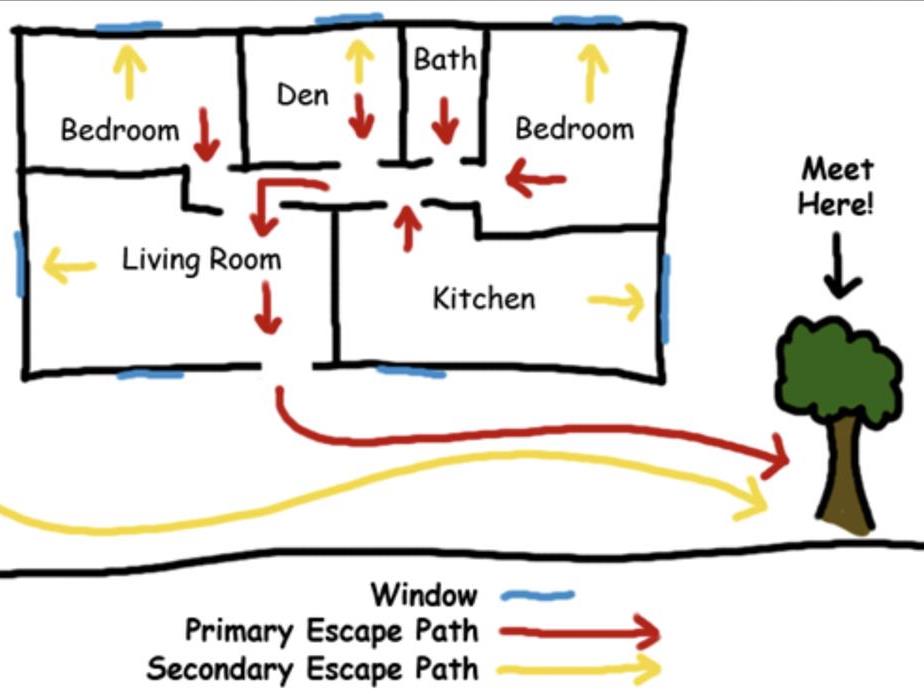 Do you have a fire escape plan at home?
Do you have a fire escape plan at home?
Escape planning tips
- Pull together everyone in your household and make a plan. Walk through your home and inspect all possible exits and escape routes. Households with children should consider drawing a floor plan of your home, marking two ways out of each room, including windows and doors. Also, mark the location of each smoke alarm.
- A closed door may slow the spread of smoke, heat and fire. Install smoke alarms in every sleeping room, outside each sleeping area and on every level of the home. NFPA 72, National Fire Alarm Code® requires interconnected smoke alarms throughout the home. When one sounds, they all sound.
- When you walk through your plan, check to make sure the escape routes are clear and doors and windows can be opened easily.
- Choose an outside meeting place (i.e. neighbor's house, a light post, mailbox, or stop sign) a safe distance in front of your home where everyone can meet after they've escaped. Make sure to mark the location of the meeting place on your escape plan.
- Go outside to see if your street number is clearly visible from the road. If not, paint it on the curb or install house numbers to ensure that responding emergency personnel can find your home.
- Have everyone memorize the emergency phone number of the fire department. That way any member of the household can call from a neighbor's home or a cellular phone once safely outside.
- If there are infants, older adults, or family members with mobility limitations, make sure that someone is assigned to assist them in the fire drill and in the event of an emergency. Assign a backup person too, in case the designee is not home during the emergency
- If windows or doors in your home have security bars, make sure that the bars have emergency release devices inside so that they can be opened immediately in an emergency. Emergency release devices won't compromise your security - but they will increase your chances of safely escaping a home fire.
- Tell guests or visitors to your home about your family's fire escape plan. When staying overnight at other people's homes, ask about their escape plan. If they don't have a plan in place, offer to help them make one. This is especially important when children are permitted to attend "sleepovers" at friends' homes.
- Be fully prepared for a real fire: when a smoke alarm sounds, get out immediately. Residents of high-rise and apartment buildings (PDF) may be safer "defending in place."
- Once you're out, stay out! Under no circumstances should you ever go back into a burning building. If someone is missing, inform the fire department dispatcher when you call. Firefighters have the skills and equipment to perform rescues.
Put your plan to the test
- Practice your home fire escape plan twice a year, making the drill as realistic as possible.
- Make arrangements in your plan for anyone in your home who has a disability.
- Allow children to master fire escape planning and practice before holding a fire drill at night when they are sleeping. The objective is to practice, not to frighten, so telling children there will be a drill before they go to bed can be as effective as a surprise drill.
- It's important to determine during the drill whether children and others can readily waken to the sound of the smoke alarm. If they fail to awaken, make sure that someone is assigned to wake them up as part of the drill and in a real emergency situation.
- If your home has two floors, every family member (including children) must be able to escape from the second floor rooms. Escape ladders can be placed in or near windows to provide an additional escape route. Review the manufacturer's instructions carefully so you'll be able to use a safety ladder in an emergency. Practice setting up the ladder from a first floor window to make sure you can do it correctly and quickly. Children should only practice with a grown-up, and only from a first-story window. Store the ladder near the window, in an easily accessible location. You don't want to have to search for it during a fire.
- Always choose the escape route that is safest – the one with the least amount of smoke and heat – but be prepared to escape under toxic smoke if necessary. When you do your fire drill, everyone in the family should practice getting low and going under the smoke to your exit.
- Closing doors on your way out slows the spread of fire, giving you more time to safely escape.
- In some cases, smoke or fire may prevent you from exiting your home or apartment building. To prepare for an emergency like this, practice "sealing yourself in for safety" as part of your home fire escape plan. Close all doors between you and the fire. Use duct tape or towels to seal the door cracks and cover air vents to keep smoke from coming in. If possible, open your windows at the top and bottom so fresh air can get in. Call the fire department to report your exact location. Wave a flashlight or light-colored cloth at the window to let the fire department know where you are located.
https://www.nfpa.org/Public-Education/Staying-safe/Preparedness/Escape-planning
Firework Safety
6/25/2021 (Permalink)
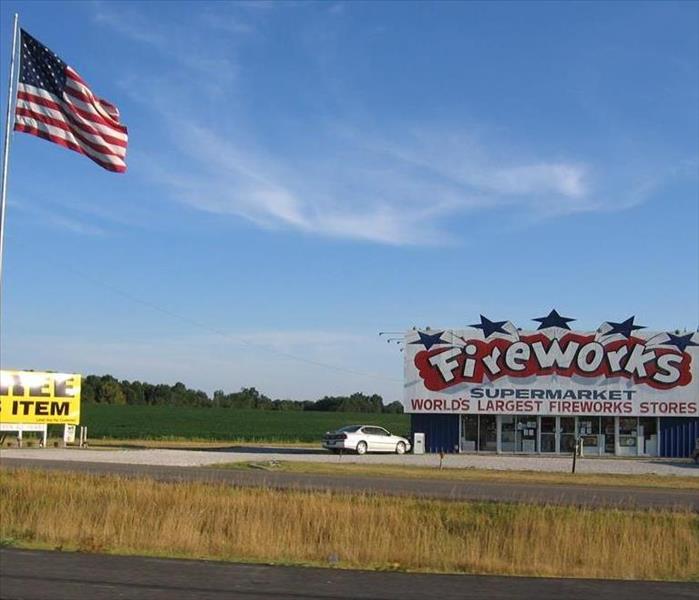 Firework Stand
Firework Stand
Summer is synonymous with barbecues, swimming, and fireworks. Today we will cover Firework safety.
If not handled properly and safely, Fireworks can be extremely dangerous, causing bodily injury and even structure fires.
The National Safety Council advises everyone to enjoy fireworks at public displays conducted by professionals, and not to use any fireworks at home. They may be legal, but they are not safe.
In 2017, eight people died and over 12,000 were injured badly enough to require medical treatment after fireworks-related incidents. Of these, 50% of the injuries were to children and young adults under age 20. Over two-thirds (67%) of injuries took place from June 16 to July 16. And while most of these incidents were due to amateurs attempting to use professional-grade, homemade or other illegal fireworks or explosives, an estimated 1,200 injuries were from less powerful devices like small firecrackers and sparklers.
Additionally, fireworks start an average of 18,500 fires each year, including 1,300 structure fires, 300 vehicle fires and nearly 17,000 other fires.
If consumer fireworks are legal to buy where you live and you choose to use them, be sure to follow the following safety tips:
- Never allow young children to handle fireworks
- Older children should use them only under close adult supervision
- Never use fireworks while impaired by drugs or alcohol
- Anyone using fireworks or standing nearby should wear protective eyewear
- Never hold lighted fireworks in your hands
- Never light them indoors
- Only use them away from people, houses and flammable material
- Never point or throw fireworks at another person
- Only light one device at a time and maintain a safe distance after lighting
- Never ignite devices in a container
- Do not try to re-light or handle malfunctioning fireworks
- Soak both spent and unused fireworks in water for a few hours before discarding
- Keep a bucket of water nearby to fully extinguish fireworks that don't go off or in case of fire
- Never use illegal fireworks
A Tip on SPARKLERS
Every year, young children can be found along parade routes and at festivals with sparklers in hand, but sparklers are a lot more dangerous than most people think.
Sparklers burn at about 2,000 degrees – hot enough to melt some metals. Sparklers can quickly ignite clothing, and children have received severe burns from dropping sparklers on their feet. According to the National Fire Protection Association, sparklers alone account for more than 25% of emergency room visits for fireworks injuries. For children under 5 years of age, sparklers accounted for nearly half of the total estimated injuries.
Consider using safer alternatives, such as glow sticks, confetti poppers or colored streamers.
The best choice might be to grab a blanket and a patch of lawn, kick back and let the experts handle the fireworks show.
Visit www.travelok.com for Independence Day, Fourth of July and Firework shows near you.
If you have any questions, call your SERVPRO® of Mayes and Wagoner Counites, 918-486-1055. 24/7 Emergency Response. Always FREE Estimates for any job.
SERVPRO® of Mayes and Wagoner Counties specializes in Fire and Water Cleanup and Restoration.
SERVPRO® has an A+ rating with the Better Business Bureau.
Grilling Summer Safety
6/25/2021 (Permalink)
Summer is synonymous with barbecues, swimming, and fireworks. Today we will cover Grilling safety.
Seven out of every 10 adults in the U.S. have a grill or smoker*, which translates to a lot of tasty meals. But it also means there is an increased risk of home fires.
In 2014-2018, fire departments went to an annual average of 8,900 home fires involving grills, hibachis, or barbecues per year, including 3,900 structure fires and 4,900 outside or unclassified fires.
Grilling fire facts
July is the peak month for grill fires (18%), including both structures, outdoor or unclassified fires, followed by June (15%), May (13%) and August (12%).
In 2014-2018, an average of 19,700 patients per year went to emergency rooms because of injuries involving grills.** Nearly half (9,500 or 48%) of the injuries were thermal burns, including both burns from fire and from contact with hot objects; 5,200 thermal burns, per year, were caused by such contact or other non-fire events.
Children under five accounted for an average of 2,000 or 39%, of the contact-type burns per year. These burns typically occurred when someone, often a child, bumped into, touched or fell on the grill, grill part or hot coals.
Gas grills were involved in an average of 8,900 home fires per year, including 3,900 structure fires and 4,900 outdoor fires annually. Leaks or breaks were primarily a problem with gas grills. Ten percent of gas grill structure fires and 22% of outside gas grill fires were caused by leaks or breaks.
Charcoal or other solid-fueled grills were involved in 1,300 home fires per year, including 600 structure fires and 600 outside fires annually.
Here are 10 Do’s and Don’t Tips
DO:
- Keep your grill at least 10 feet away from your house. Farther is even better. This includes portions attached to your house like carports, garages and porches. Grills should not be used underneath wooden overhangs either, as the fire could flare up into the structure above. This applies to both charcoal and gas grills.
- Clean your grill regularly. If you allow grease and fat to build up on your grill, they provide more fuel for a fire. Grease is a major source of flare ups.
- Check for gas leaks. You can make sure no gas is leaking from your gas grill by making a solution of half liquid dish soap and half water and rubbing it on the hoses and connections. Then, turn the gas on (with the grill lid open.) If the soap forms large bubbles, that's a sign that the hoses have tiny holes or that the connections are not tight enough. Turn the main gas valve off after each use.
- Keep decorations away from your grill. Decorations like hanging baskets, pillows and umbrellas look pretty AND provide fuel for a fire. To make matters worse, today's decor is mostly made of artificial fibers that burn fast and hot, making this tip even more important.
- Keep a spray bottle of water handy. That way, if you have a minor flare-up, you can spray it with the water to instantly calm it. The bonus of this tip is that water won't harm your food, so dinner won't be ruined!
- Keep a fire extinguisher within a couple steps of your grill. And KNOW HOW TO USE IT. If you are unsure how to use the extinguisher, don't waste time fiddling with it before calling 911. Firefighters say many fire deaths occur when people try to fight a fire themselves instead of calling for expert help and letting the fire department do its job.
DON’T
- Turn on the gas while your grill lid is closed. NEVER do this. It causes gas to build up inside your grill, and when you do light it and open it, a fireball can explode in your face.
- Leave a grill unattended. Fires double in size every minute. Plan so that all of your other food prep chores are done and you can focus on grilling.
- Overload your grill with food. This applies especially fatty meats. The basic reason for this tip is that if too much fat drips on the flames at once, it can cause a large flare-up that could light nearby things on fire.
- Use a grill indoors. People often think it will be safe to use a grill, especially a small one, indoors. NOT TRUE. In addition to the fire hazard, grills release carbon monoxide, the deadly colorless, odorless gas. That gas needs to vent in fresh air, or it can kill you, your family and pets.
For more information on fire or grill safety, visit www.nfpa.org
Source: NFPA's Applied Research. * Hearth, Patio and Barbecue Association (HPBA). **Consumer Product Safety Commission’s National Electronic Injury Surveillance System, queried in April 2016
If you have any questions, call your SERVPRO® of Mayes and Wagoner Counites, 918-486-1055. 24/7 Emergency Response. Always FREE Estimates for any job.
SERVPRO® of Mayes and Wagoner Counties specializes in Fire and Water Cleanup and Restoration.
SERVPRO® has an A+ rating with the Better Business Bureau.
Types of Smoke and Fires
5/4/2021 (Permalink)
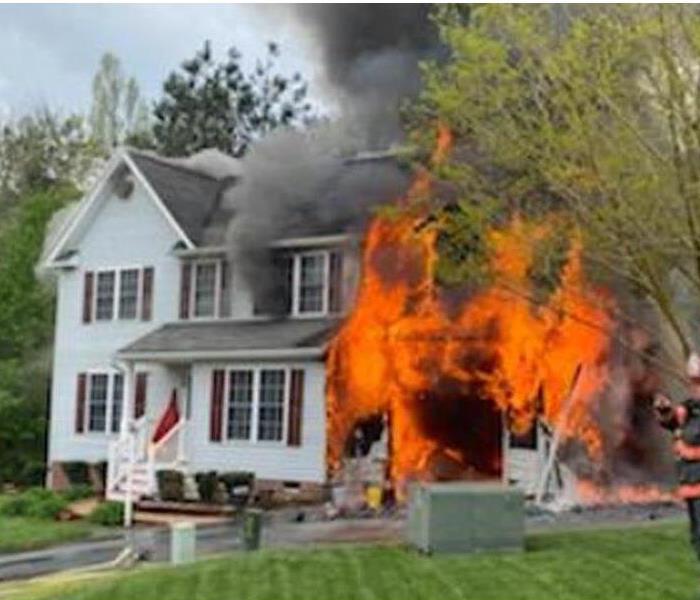 House fire in Pryor, Oklahoma
House fire in Pryor, Oklahoma
Fire is divided into five classes (A, B, C, D, and K) that are primarily based on the fuel that is burning. This classification system helps to assess hazards and determine the most effective type of extinguishing agent.
CLASS A – Involve common combustibles, such as wood, paper, cloth, rubber, trash, and plastics.
CLASS B – Involve flammable liquids, solvents, oil, gasoline, paints, lacquers, and other oil-based products.
CLASS C – Involve energized equipment such as wiring, controls, motors, machinery, or appliances.
CLASS D – Involve combustible metals such as magnesium, lithium, and titanium.
CLASS K - Involve combustible cooking media such as oils and grease commonly found in commercial kitchens.
As well as different types of fires, there are different types of smoke, wet and dry. With the different types of smoke comes different types of soot residue after a fire.
Before restoration can begin, SERVPRO® of Mayes and Wagoner Counties Technicians will test the soot to determine which type of smoke damage occurred. The cleaning procedures will then be based off the information from the testing.
Here are some examples of the different types of smoke.
Wet Smoke – Plastic and Rubber – Normally low heat, smoldering fire, leaves a pungent odor, sticky to the touch, and smeary throughout the structure. Leaves smoke webs.
Dry Smoke – Paper and Wood – Typically fast burning, high temperatures, heat rises throughout the structure and therefore smoke rises.
After the fire there may be more than just damage from the fire itself. Protein Fire Residue – Produced by evaporation of material rather than from a fire – It is virtually invisible, discolors paints and varnishes, it can leave an extreme pungent odor.
If you have any questions, call your SERVPRO® of Mayes and Wagoner Counites, 918-486-1055. 24/7 Emergency Response. Always FREE Estimates for any job.
SERVPRO® of Mayes and Wagoner Counties specializes in Fire and Water Cleanup and Restoration.
SERVPRO® has an A+ rating with the Better Business Bureau.
Space Heater Fire Safety
12/11/2020 (Permalink)
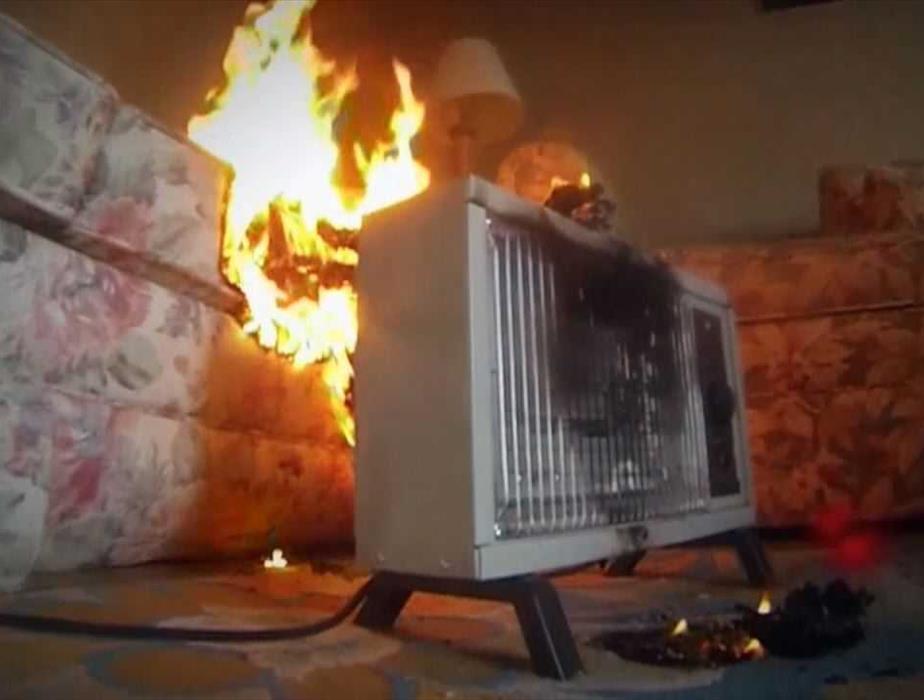 Space Heaters cause 1/3 of the winter home fires in the US every year.
Space Heaters cause 1/3 of the winter home fires in the US every year.
As the temperatures drop, many people turn to space heaters to supplement their heating system or sometimes rely on them entirely for warmth. Unfortunately, space heaters cause about one-third of all winter house fires and 80 percent of all winter heating fire deaths, according to the National Fire Protection Association (NFPA). The winter months of December, January and February are the leading months for home heating fires.
Portable heaters can be both efficient and economical and add direct warmth to the rooms you are using most frequently, however there are few things to keep in mind when using them.
- When shopping for a space heater make sure to buy one that fits your needs. Look for what square footage the heater is suggested for.
- Make sure to buy a heater with overheat protection.
- Look for a heater with “tip over” protection. This feature shuts the space heater off if it accidentally tips over.
- Look for a heater that has a cool touch feature, where if touched by children or pets it will not burn.
- Plug your heater directly into a wall outlet. Never use an extension cord not rated for the heater or “surge protector” outlets. These are the main causes for overheating and electrical fires.
- Avoid using space heaters in humid areas, such as bathrooms or laundry rooms.
- Avoid using space heaters unsupervised and while you’re not at home.
- Do not let children play with or within three feet of space heaters. Left toys are a common cause of fires.
Do not let your Holliday season burn out and go up in flames , educate yourself about the safety hazards that come with the improper use of space heaters will help you achieve better peace of mind as you keep your home warm, comfortable, and fire hazard-free this winter.
SERVPRO specializes in Fire and Water Cleanup and Restoration.
If you have any questions, call your SERVPRO of Mayes and Wagoner Counites, 918-486-1055. 24/7 Emergency Response.
Types of Fires
5/6/2020 (Permalink)
Many people don't know this but there are different types of smoke.
There are two different types of smoke–wet and dry. As a result, there are different types of soot residue after a fire. Before restoration begins, SERVPRO of Mayes and Wagoner Counties will test the soot to determine which type of smoke damage occurred. The cleaning procedures will then be based on the information identified during pretesting. Here is some additional information:
Wet Smoke – Plastic and Rubber
- Low heat, smoldering, pungent odor, sticky, smeary. Smoke webs are more difficult to clean.
Dry Smoke – Paper and Wood
- Fast burning, high temperatures, heat rises therefore smoke rises.
Protein Fire Residue – Produced by evaporation of material rather than from a fire
- Virtually invisible, discolors paints and varnishes, extreme pungent odor.






 24/7 Emergency Service
24/7 Emergency Service







